Christmas Mint Slice Balls (No-Bake)
These are the best!! Out of everything I make, I think this is what people love the most. I can’t tell you how easy they are. I have been so happy since Coles makes gluten free mint slice, so now those with severe dietary needs are catered for.
Ingredients:
- Arnott’s Mint Slice or Coles I’m Free From Choc Mint for Gluten Free Version – 2 x whole packets
- 250g full cream cheese, softened
- 180g milk chocolate
- 1 tablespoon coconut or vegetable oil (optional for melted chocolate)
- Red/Green M&M’s or for gluten free I use slivered almonds and cranberries to decorate











Almond & Cranberry Biscotti
Another really easy Christmas recipe, although it doesn’t have to be just for this time of year.
Incredibly easy and I’m sure you can add any dried fruit or nuts to the mixture.
Ingredients:
- 1 egg
- 1 egg yolk
- 2/3 cup caster sugar
- 1/2 teaspoon almond essence
- 1 1/3 cups plain flour
- 1/2 teaspoon baking powder
- 1/4 cup slivered almonds
- 1/4 cup pistachios
- 1/4 cup dried cranberries
Method:
- Preheat over to 180C/160C fan-forced. Line 2 large baking trays with baking paper.
- Using an electric mixer, beat the egg, egg yolk and essence in a large bowl until pale and thick.











Finally, stand on trays for about 5 mins. Then transfer to a wire rack to cool.
Christmas White Chocolate Rocky Road
It’s been an incredibly long time since I’ve posted and I felt I had to share my recipes for Christmas. Every year I get incredibly excited for Christmas, and it has become a yearly tradition to bake and give these as gifts. Then I remember the massive process involved with having to buy specific ingredients, deal with the crowds and the worst part…the heat and humidity and everything melting and nothing setting – ah Aussie Summer. But…I still absolutely love it!
This Rocky Road has to be the best in my opinion. Why? The colours are everything you can ask for. Aaand you can’t fail!
Ingredients:
- 2 x 180g packets of white chocolate (chopped)
- 1/2 cup natural pistachios (out of shell)
- 1 cup mini marshmallows (large are ok, I would chop in half)
- 1/2 cup dried cranberries
- 1/4 cup desiccated coconut
- ** optional – add slivered almonds, use 1 packet of milk or dark chocolate on top.
Method:
- Line a square baking tray (I use foil).
- Melt the chocolate in a microwave safe bowl. I do this in bursts of 20 seconds.
- Add all the other ingredients and stir so everything is covered.
- Put in the fridge to set, ideally overnight.
- Lift foil and then chop into desired pieces – I usually do small squares.











And to finish as gifts – (I have more recipes, Choc Mint Christmas Balls and Biscotti)




Trauma & Addiction…
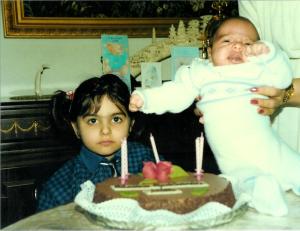
This picture makes me laugh so much, I was clearly suffering from Middle Child Syndrome – I wasn’t happy that the arrival of my baby brother was over-shadowing my 5th birthday.
Recently I completed my studies in Counselling with no intention of working as a counsellor. Weird I know…
Someone once asked me if I was addicted to studying. I’m not, or maybe I am. I actually enjoy learning, meeting new people and having shared thoughts. But I also like the brain stimulation, the stress of deadlines, the amazing feeling when I handed in an assignment. By the way, I don’t pretend to be in any way cool….
Truthfully, I started my degree in Early Childhood for a number of reasons – there is a ‘joke’ – or perhaps it is more of an understanding, that we become Early Childhood Educators because we ourselves missed out on a childhood.

Bachelor of ECT – 2004
I finished my undergraduate degree in Early Childhood and was and always will be incredibly passionate about child development. I then completed a postgrad specialising in Early Childhood Education, followed by my Masters specialising in the Early Childhood and the Multicultural classroom. I wanted to start a doctorate, but by that stage child development was not as strong a focus for me. Besides, I think my mum was done trying to find a place for the framed pictures and degrees at her place.
The reason I enrolled in the Counselling degree was due to having several people in my life with addictions. I honestly did not understand why and how someone could voluntarily want to get high, drink, gamble, smoke so excessively to the point it could destroy the relationships around them. To give up one of those things was harder than fighting for those that you cared about.
That line. Can I just say has brought me to tears. I have just had a flash of those people I had to say goodbye to over the years. It took me a very long time, I am talking years for me to understand that while felt I was supporting these people through their tough times, I was actually enabling them. I was, in their heads, accepting of their addictions.
When I first moved to Japan, as incredible and exciting experience as it was, the first year away was also my loneliest, I had also come out of a 3 year relationship and I thought by moving overseas this would help – of course it did not, and I found myself studying to fill that void as best as I could.

Postgraduate in Education – 2006
I started working as a consultant in the EC field and met an amazing group of professionals who all shared an incredible amount of knowledge, but I also found we had different strengths when it came to creating an inclusive Early Childhood program.
Through my caseload, I began to read many different reports and assessments on children with additional needs. It was here that I began to see some links with high needs children with challenging behaviour where one or both of the parents had history of trauma either with themselves or in the family. I then began to see the future links with trauma in Early Childhood and on-going issues in adult life, especially with mental illness and addictions. For this reason I wanted to go beyond reading a variety of articles and learn more at university, so I began studying again!
Note, I am not a psychologist, I am not a counsellor, the information I have found is based on research that I found beneficial to answering some of my questions. I understand that some people may not agree with my views, however I do believe the trauma that can occur in the early years can be supported – and hopefully allow a child to continue being a child.
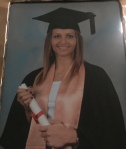
Postgraduate in Counselling – 2016
I found the information to be incredibly intriguing as to the links between trauma and supporting a child’s well-being through this time. This is where the importance of Circle of Security comes into play.
What is trauma?
I think this article from KidsMatter explains Trauma in the Early Years clearly “it is important to remember that trauma is not the event but the reaction to the event“. The response to the event will vary from person to person, child to child. The effects on the individual will also depend on the reaction to the response. For example, if the response is prolonged, this can embed the trauma and therefore become long-term trauma or lead to post-traumatic stress disorder.
Supporting Trauma:
The best way to support a child through trauma is to ensure that the child is safe and genuinely feels safe. It is also important to talk through the what has happened, what is happening and to label the emotions. I refer to Circle of Security. The program is nothing revolutionary and is the basis of everything we know and understand in Early Childhood.
An Example:
A few years ago I taught a 4 year old who despite being in child care from 6 weeks, without fail she would cry at drop off and separation from mum and dad was difficult for everyone involved. When the child – let’s call her Ellie started at my centre, I was immediately told by the parents this information. I encouraged prior orientation, and Ellie became very familiar with myself and the other educators. Within a few weeks, Ellie had settled really well, there were no tears and she was engaging with peers and thriving. All seemed perfect…so I thought.
Mum then explained Ellie’s high anxiety over the weekend and on the drive to preschool, none of which was observed at the centre and she never exhibited this with dad either. As we got to know each other better, more information was shared, to which I then learnt Ellie had gone through a very traumatic experience and had been in and out of hospital for the first few years of her life to correct issues with her stomach. On each occasion to the hospital, it was mum who had taken her.
Ellie’s anxiety was embedded responses to the intrusive medical procedures. With the family, we researched and found a wonderful child psychologist who was able to support them and enabled Ellie to work through her emotions.
It is important to recognise that sometimes as an educator or parent this is not an area of expertise, which is why they are child psychologists. Understandably this can be a high cost, however Medicare can support this with the Mental Health Care Plan which can cover all or some of the cost. Mental Health Care Plans can be accessed through your GP who can then refer you to a psychologist.
The Link to Addiction:
It is nothing new to state that childhood trauma can increase the risk of an individual developing an addiction or depression later in life, however there are different studies that also suggest changes in the brain or triggers affecting neural networks.
It makes sense, an addiction increases dopamine and therefore taking away the pain the individual may be feeling. In addition, this is an emotional response – if I am not feeling good right now, what will make me feel good?
This goes back to how we learn to self-regulate.
Here are a couple YouTube videos that explain this much better than I do;
Loving someone with an addiction is exhausting. It can and will break you. The hardest part is letting go and finally understanding that because you care you are continuing to fuel their addiction. By trying to protect them, you are accepting their addictions. But they will continue to lie, manipulate and destroy people around them. Until they seek help they cannot and will not get better. There are amazing support networks out there.
The most difficult part is understanding that the trauma they faced as an innocent child has brought them here, and until they face those demons, they will never change. In the meantime, as educators, as adults we have a voice and we need to protect the children around us.
Chocolate Mousse…

I do not have a sweet tooth, but I have limited to zero control around chocolate…I’ve heard it’s medically proven it’s good for you – enough said
When it comes to some easy, but indulgent desserts, who doesn’t love a quick but delicious chocolate mousse? This recipe literally takes about 10 minutes to prepare.
Ingredients:
- 200g dark cooking chocolate
- 50g butter
- 250ml thickened cream
- 4 eggs, separated
- 2 tablespoons caster sugar
Method:

In a microwave safe bowl, add 200g dark cooking chocolate

Add 50g butter. In a microwave melt in bursts of 30 seconds

In a separate bowl add 250ml thickened cream, whip the cream until soft peaks form

Stir butter and chocolate mixture until combined

Separate the 4 eggs, whites in one container

Add the 4 yolks to chocolate mixture

Whisk egg whites until soft peaks form

Add 2 tablespoons caster sugar until mixture is thick and sugar has dissolved

Combine chocolate and egg yolks

Add thickened cream and fold through

Add egg whites

Fold through until combined

Add into individual bowls or ramekins and set in fridge for at least 3 hours
To decorate I added some white and milk chocolate drops, but you can also add raspberries.
Blueberry & Oat Mini-Muffins…
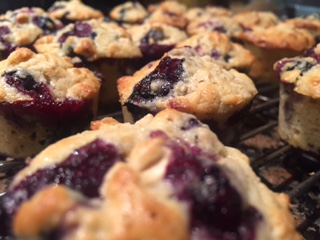
When it comes to baking, the easier the better! I like recipes that are quick and can be adapted to create something new. When I went shopping I saw blueberries were on sale and changed this original recipe which calls for bananas and added the blueberries instead. I think quite easily the fruit could be adjusted for anything from raisins to raspberries, even walnuts.
Ingredients:
- 1 1/2 cups plain flour
- 1 cup oats
- 2 1/4 teaspoons baking powder
- 1 teaspoon salt
- 1/2 teaspoon ground cinnamon
- 3/4 cup sugar
- 2 large eggs
- 90g unsalted butter, melted and cooled
- 1/2 cup milk
- 1 1/4 cups blueberries
Method:
Preheat oven to 180C. Lightly grease muffin tray – I used the mini-muffin tray to make 24, but a regular tray may make about 12.

In a mixing bowl, add dry ingredients. 1 1/12 cups plain flour

1 cup rolled oats

2 1/4 teaspoon baking powder & 1 teaspoon salt

1/2 teaspoon ground cinnamon

3/4 cup sugar. Then stir dry ingredients together.

In a separate bowl, melt 90g butter and allow to cool

Add 1/2 cup milk

Add 2 lightly beaten eggs to the mixture.

Add the liquid mixture to the dry ingredients. Add 1 1/4 cup blueberries

Using a metal spoon stir ingredients until combined.

Add mixture to muffin tray and cook for 15-20 minutes.

Allow to cool and place on wire rack to cool.
Cheoreg – Armenian Easter Bread…

“Mum, I’m going to make Cheoreg”.
My mother’s reaction to this was not really a surprise – she blankly stared at me and responded with “why, when you can buy it?”
Traditions:
My family story can be viewed as a complicated one, and for a very long time I felt quite lost with my identity. It is only now, in my mid-thirties, that I can embrace my cultural background.
My parents are Armenian, yet I was born in Switzerland, and have spent a majority of my life living in Australia. A close friend of mine described me as being 70% European, 30% Aussie…I’d say that changes back and forth on a daily basis.
Growing up, I always felt out of place in my social circle and even in my family. It was

My uncle & nana who both passed away in 2012.
only when I met two of my Great-Aunts that I finally felt I made sense. My Grandmother (Nana) was the matriarch. She rarely smiled. She rarely hugged us. Nana was a tough lady that we all truly believed would outlive us all. To this day we do not actually know how old she was when she passed away as she had no papers when leaving Iran and created some ‘younger’ birthdate.
But Nana was the one who followed the Armenian traditions, and when she passed away in 2012 so did the Armenian family gatherings. 6 months later, my wonderful Uncle passed and my already very small family was halved.
This year I wanted to bring back these traditions and so hence why I decided to make Cheoreg. What’s Cheoreg? Armenian Easter Bread.
Armenian Easter:
The traditions we celebrate are not about religion. Two things I love about Easter is the decorating of the eggs and the pilaf with crispy potatoes. We also eat kuku sabzi and smoked cod.
This year I also decided to make Cheoreg, which I have never made before. The recipe itself is easy to follow, however it’s a lengthy process, and to be honest it tasted amazing, but I’m not sure I got the texture right, and I think I didn’t bake it long enough. But then my family & friends polished it off pretty quickly! I hope my Nana would have been proud. The fragrance while baking filled the home, so overall I am really happy I made it – will attempt again next year 🙂
One of the ingredients is Mahleb which I purchased from the Lebanese/Armenian deli in Willoughby – but I think is available at most Middle Eastern supermarkets.
* This recipe will make 3 loaves.
Ingredients:
- 1 cup milk
- 1 tablespoon sugar
- 1 packet active dry yeast or 2¼ teaspoons active dry yeast from a jar
- ½ cup butter (1 stick)
- 5 large eggs (+ 1 yolk for the egg wash)
- ¾ cup sugar
- 1 tablespoon vanilla extract
- 1½ tablespoons ground mahleb
- 6 cups all purpose flour + ½ cup for kneading
Method:

Add 2 cups of milk to a heat-safe jug and microwave for 1-2 minutes. Add 1 tablespoon sugar.

Add 2 1/4 teaspoon of dry yeast and stir mixture. Let sit for 25-30 minutes.

In a separate bowl add 1/2 cup of butter and melt.

Leave melted butter to sit for same time as milk mixture.

In a large bowl, add 5 eggs

Add 3/4 cup sugar

1 tablespoon of vanilla extract

Mahleb – or Mahlepi in Greek

Add 1 1/2 tablespoons of Mahelb

Stir mixture

Add the milk mixture and melted butter

Next, add 6 cups of flour to the liquid

Using a wood spoon, combine the ingredients together. This will be quite sticky.

Turn the dough out onto a floured surface and knead until no longer sticky (about 5 minutes) – you may need more flour depending on the weather.

Grease a large bowl with butter and add the dough. Cover with cling wrap

Cover this with a tea-towel. Let dough sit for 5-7 hours so it doubles in size.


Turn dough out onto a lightly flour surface and knead.

Divide the dough into 3, and then into 3 sections again

Roll out into about 30-40cm ropes.

Braid the ropes and then turn into a circle. Put onto a baking tray with grease-proof paper and then cover with a tea-towel. Let sit for 20-25 minutes.

Preheat oven to 180C. Then make an eggwash – using one egg white and a tiny bit of water and brush onto the loaves.

Bake for 25-30 minutes, or until dark and golden on top (so baking time may vary with your oven). Remove from oven and let cool on wire cooling rack.
Then eat with some butter or jam – cherry is my favourite!
White Chocolate Chip & Cranberry Cookies…

As a child was always hovering around my parents as they cooked. I think it came to mum as a huge relief when I began offering to cook the family dinners and bake. Still at mums place now there is a big plastic container full of ‘my things’ – ranging from holiday themed patty cases to cookie cutters that I have purchased over the years. I have always loved trying to make something new, and I was really fortunate to have 2 brothers who absolutely devoured anything that was put in front of them – and they are fortunate that they attend the gym regularly!
When it comes to cooking, I really enjoy it and it is no doubt the European in me that believes cooking for people is a way of showing you care. It should be fun, and easy and a time to allow yourself to be creative.
I love recipes that are simple yet different, and these white chocolate chip and cranberry cookies just tick every box.
Ingredients:
- 1 2/3 cup plain flour
- 1 1/2 teaspoon baking soda
- 1 cup brown sugar
- 1/2 cup shredded coconut
- 1/2 cup dried cranberries
- 1/2 cup white chocolate drops
- 150g butter
- 1 egg
Method:

First, preheat your oven to 160C (fan forced). Add 1 2/3 cup of plain flour and 1 1/2 teaspoon of baking soda

Sift into a large bowl.

Add 1 cup of brown sugar

Add 1/2 cup of shredded coconut

Next add 1/2 cup of dried cranberries

And then 1/2 cup of white chocolate drops

In a microwave safe bowl, melt 150g butter of butter and add to the dry ingredients.

Lightly beat an egg and add to mixture
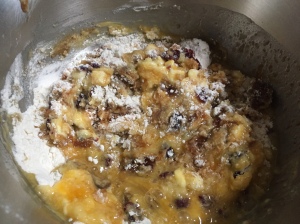
Using a metal spoon, combine the ingredients
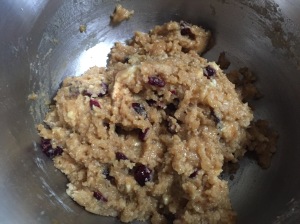
Until they all come together

On a tray lined with baking paper, spoon out the mixture

This should make about 24.

Pop into the oven for about 12-15 minutes.

Bake until they are nice and golden.
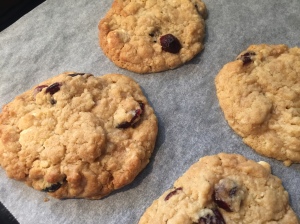
Bon Appetit!
Reflection on Practice…
For the past 12 months, I have been facilitating Reflection on Practice (RoP) Sessions. I have been working collaboratively with other Early Childhood Professionals to put together sessions on Positive Behaviour Guidance and Using Communication and Visuals to Support the Care Environment.
Based on the feedback that was received after the sessions, many Educators reflected they wanted more training and strategies on behaviour.
If you always do what you’ve always done, you always get what you’ve always got…
Recently, I facilitated the first RoP session titled “Tools to Support the Care Environment”. In the past the sessions have been limited to 8 Educators and to 2 hours. This time we allocated up to 20 spots and this RoP would be held over 2 sessions of 3 & 2 hours. In putting this session together, I worked collaboratively with a colleague of mine Lisa, who has worked in the field of inclusion for many years. She also still currently teaches support classes at a Primary School in Sydney.
Lisa has over 10 years teaching experience and has worked in a variety of roles ranging from Early Intervention and supporting families through to working 7 years in an Autism Specific School. With extensive experience teaching children with additional needs such as ASD and Cerebral Palsy, Lisa has highly specialised skills with supporting the care environment through the use of visuals and Makaton (now Keyword Sign).
Understanding what is behaviour:
When a child consistently presents with behaviours that are challenging or puzzling, our first response is often instinctive. This response is based on our own experience as children and/or as parents. This initial response may be unhelpful bringing with it a complex web of relationships, values and expectations that hold little relevance to the child and their situation.
If we want to have a better understanding of children’s behaviour, we need to view it though a new lens. The ‘Circle of Security’ model (Marvin, Cooper, Hoffman & Powell, 2002) is one way. This model translates attachment theory (which is complex) into a working model for both parents and childcare staff to apply to their daily practice.
We need to;
- Manage roles so that there is always an adult physically and emotionally available to children.
- Being aware of where children are on the circle and what intervention is required to help them manage their emotions.
- Providing safe hands for each child – a refuge for when their emotions are too big for them to manage.
- Reflecting on how we can support all children to effectively use the circle, at the same time teaching emotional regulation.

For more information on Circle of Security, you can purchase Robyn Dolby’s “The Circle of Security: Roadmap to building supportive relationships” (e-version) from the Early Childhood Australia shop. Currently this is reduced to $10.
Considering our Care Environment:
During this RoP session we reflected on the impact of the Early Childhood environment. Below is a visual to highlight that the minute we walk in the door to work, our bubble expands to include Children, Families, Educators and our own outside negative (or positive) influences.

The responses shared by the Educators at the RoP were that this image was overwhelming. Some other feedback included;
“Understanding to be more patient and communicate more with co-workers.”
“To ensure to share ideas with all Educators.”
“Reflect on the environment more regularly.”
“To consider thinking about all people who are involved in the environment.”
“To remember everyone has impacts in their live.”
In considering keeping our children to feel safe and secure, we need to look at our Care Environment; we need to look at many different aspects. These include;
- Layout
- Consistent Routines “How do we do that?”
- Consistent Educators
- Consistent rules & values “Who’s involved?”
- Language “Are we talking positively?”
- Child appropriate
- Consistent approach with challenges or is the same outcome & consequence for each scenario
Reflecting on our Teaching:
We split into groups and reflected on our care environments and considered some of the challenges we encounter on a regular basis. Many Educators shared very similar scenarios and we reflected on some of our own personal barriers. Professionally supporting each other we looked closely at strategies for visuals, routines, transitions and expectations of the children, our colleagues and ourselves. Below are examples of visuals; Quadrant turn-taking clock and Boardmaker Visuals for Group Time.


The Early Years Learning Framework (EYLF) has some fantastic resources which are easily accessible and free. These range from templates to videos which can be used as great supportive tools. Here are some links;
Reflective Practice: http://www.earlychildhoodaustralia.org.au/nqsplp/e-learning-videos/talking-about-practice/reflecting-on-practice/
Thinking about Practice: http://www.earlychildhoodaustralia.org.au/nqsplp/wp-content/uploads/2012/05/EYLFPLP_Thinking_about_practice_Planner_Screen.pdf
Professional Learning Program Materials: http://www.earlychildhoodaustralia.org.au/nqsplp/wp-content/uploads/2012/05/EYLFPLP_E-Newsletter_No20.pdf
Further Professional Development:
If you would like for Lisa or myself (or both) to provide further support through role-modelling or facilitate a Reflection on Practice Session at your service, you can PM via beingmissevie@gmail.com (please note we are in the area of Sydney, NSW).
Children’s Services Central: http://www.cscentral.org.au/development/cscentral-professional-development.html
Early Learning Association Australia: https://elaa.org.au/services_resources/training
Hot Cross Buns…

Heading closer to Easter and while bakeries and supermarkets have been selling hot cross buns since the 26th December, I’m not complaining, it’s probably the only time I really eat bread…and the chocolate chip ones are a little bit amazing…did I mention I have a weak spot for chocolate 🙂
So considering cooking with children, anything that encourages children to work together, be creative thinkers, build on their literacy & numeracy skills, can only be beneficial for their development, cognition, and social and emotional well-being…if they can get their hands dirty…that’s a considerable bonus!!
Here is a very simple recipe for making Hot Cross Buns.
Ingredients:
- 27 g sachet Dry Yeast (or 30g fresh yeast)
- 300 ml Milk, warmed
- 4 cups Plain Flour
- 1 tsp Ground Cinnamon
- 90 g Butter, chopped
- 1 ½ cups Mixed Dried Fruit
- 1/4 cup Caster Sugar
- 1 Egg
Crosses:
- 4–5 tbsp Water
- 1/2 cup Plain Flour
Glaze:
- 1/4 cup Water
- 1/4 cup Sugar
- 1 tsp Mixed Spice
Method:

Warm 300ml milk, add sachet of dried yeast. Stir and leave in a warm place for 5 minutes until mixture is foamy.

Let 90g of butter soften.

In a mixing bowl add 4 cups of plain flour.

Add 1 teaspoon of ground cinnamon.

Add softened butter and rub togteher with fingertips.

Add 1 1/2 cups of dried fruit. I added cranberries and mixed dried peel.

Add 1/4 cup caster sugar. Stir mixture together.

To the milk mixture, add 1 egg and whisk. Add to the flour mixture.

Combine mixture and knead, knead, knead.

Transfer to a lightly greased bowl and leave in a warm place to double in size.

Dough will have doubled in size. Preheat oven to 220C.

Punch dough with your fist.

Separate the dough into 16 pieces. Add to a greased tray. Placing close together.

Mix 1/2 cup plain flour with 4-5 tablespoons of water. Mix to create a paste.

You can use a piping bag, but I used a teaspoon. I call this the rustic look 🙂

Put into the oven and bake for 10 minutes.

Reduce oven to 200C and bake for further 10 minutes.

To make glaze, simmer 1/4 cup water, 1/4 cup sugar and 1 teaspoon of mixed spice.
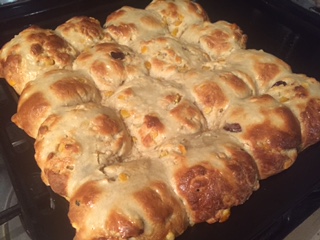
Brush over hot buns.

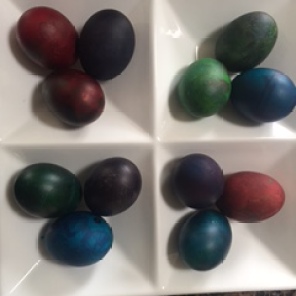
Recent Comments